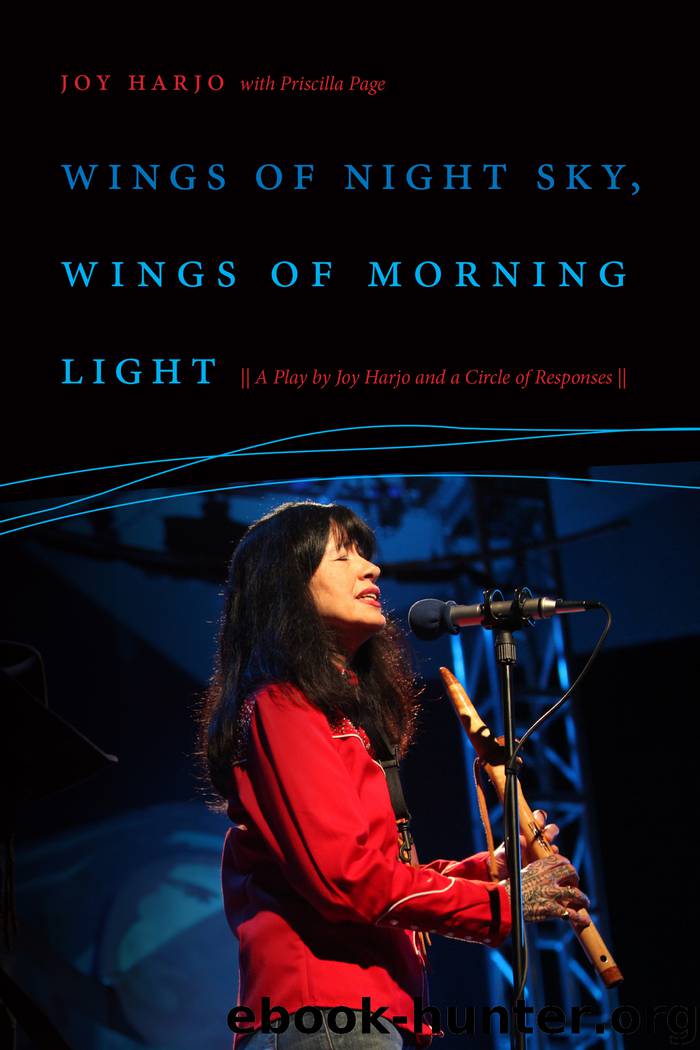Wings of Night Sky, Wings of Morning Light by Joy Harjo

Author:Joy Harjo [Harjo, Joy]
Language: eng
Format: epub
ISBN: 9780819578655
Publisher: Wesleyan University Press
Published: 2019-01-15T07:00:00+00:00
PRISCILLA PAGE
Imagining a Contemporary Native Theater || An Interview with Rolland Meinholtz
It was in the fires of creativity at the Institute of American Indian Arts that my spirit found a place to heal.
Joy Harjo, Crazy Brave
In her memoir Crazy Brave, Joy Harjo shares the story of how she arrived at the Institute of American Indian Arts (IAIA) in Santa Fe, New Mexico, at the age of sixteen. It was 1967, and she describes the city as “the epicenter of hippiedom in the West” (86). She decided at an early age that she could not live at home with her stepfather. She also knew that she wanted to be at an Indian boarding school, where she could live and study with other Indian students in “a place where [she] would belong, where [she] would be normal” (82). She learned about IAIA and submitted her application along with her original visual art. Reflecting on IAIA, she writes:
As we made art, attended cultural events, and struggled with family and tribal legacies, we sensed that we were at the opening of an enormous indigenous cultural renaissance, poised at the edge of an explosion of ideas that would shape contemporary Indian art in the years to come. The energy crackled. It was enough to propel the lost children within us to start all over again. We honed ourselves on that energy, were tested by it, and destroyed and recreated by it. (87)
The school was an innovation founded in 1962 during President John F. Kennedy’s administration. Visual artist and cultural educator Lloyd Kiva New and Charles Loloma, his close friend who became a renowned potter and jewelry maker, created the model when they, in cooperation with the University of Arizona in Tucson, mounted an experimental arts program for Native American young people. The resulting success of their experiment shook up the approach to Indian education that had been in place thus far (in the form of Indian boarding schools run by the Bureau of Indian Affairs) and came to the attention of Stewart Udall, then secretary of the interior. Udall, most known today for his enduring commitment to the environment and its conservation, along with his wife Ermalee, urged President Kennedy to bring this groundbreaking approach to the BIA. George Boyce, a longtime BIA official who had headed the Intermountain School as well as the schools on the Navajo Reservation at Window Rock, Arizona, was named superintendent of the newly formed Institute of American Indian Arts in Santa Fe that year.
The Institute for American Indian Arts brought arts education to an Indian school campus that for decades had focused on assimilation tactics and emphasized vocational and domestic training for young Native Americans who had been either forced to attend or sent to live there. These schools operated in a militaristic way, often included indoctrination into Christianity, and were run by bureaucrats through the BIA. Harjo describes it:
The Indian School world was rife with paradox. Formerly run like a military camp by the Bureau of Indian Affairs,
Download
This site does not store any files on its server. We only index and link to content provided by other sites. Please contact the content providers to delete copyright contents if any and email us, we'll remove relevant links or contents immediately.
| Acting & Auditioning | Broadway & Musicals |
| Circus | Direction & Production |
| History & Criticism | Miming |
| Playwriting | Puppets & Puppetry |
| Stage Lighting | Stagecraft |
Call Me by Your Name by André Aciman(19010)
Ready Player One by Cline Ernest(12885)
How to Be a Bawse: A Guide to Conquering Life by Lilly Singh(6713)
Wiseguy by Nicholas Pileggi(4616)
The Kite Runner by Khaled Hosseini(4493)
On Writing A Memoir of the Craft by Stephen King(4233)
The Crown by Robert Lacey(4122)
Audition by Ryu Murakami(4117)
Call me by your name by Andre Aciman(4089)
Harry Potter and the Cursed Child: The Journey by Harry Potter Theatrical Productions(4001)
Gerald's Game by Stephen King(3937)
The Perils of Being Moderately Famous by Soha Ali Khan(3794)
Dialogue by Robert McKee(3600)
Dynamic Alignment Through Imagery by Eric Franklin(3507)
Apollo 8 by Jeffrey Kluger(3208)
How to be Champion: My Autobiography by Sarah Millican(3199)
Seriously... I'm Kidding by Ellen DeGeneres(3110)
Darker by E L James(3096)
The Inner Game of Tennis by W. Timothy Gallwey(3011)
